Yoga in Sanskrit means “union.” It is a beautiful and fun way to unite with your mind and body. There is no denying that yoga is a magical source of finding your inner peace and creating self-awareness.
You may have noticed how more people around us are concerned about mental health. This is due to the constant stimulation of our nervous system. Not only mentally, but yoga can also affect us physically as well.
Although solo yoga is beneficial, partner or couples yoga is an excellent approach to strengthen your bond with your partner. So go ahead, grab your partner or BFF to enjoy 2 person yoga poses.
What are 2 Person Yoga Poses?
Partner yoga or yoga poses for two, can take your yoga experience to the next level in many ways. You must already know that yoga is a method of achieving physical and mental wellness where we use our body weight to activate all our muscles.
In a couples yoga class, you are paired up with another person to use each other’s body weight to perform a yoga position. Every position in this state will be dependent on each other’s coordination. This is a beautiful way to connect to your body and mind with another person’s support and trust – the perks of doing BFF 2 person yoga poses or even three people yoga poses.
It can take your flexibility to a new level. Your yoga poses are bound to improve, given you have an additional person for balance and support. Not only just fitness-wise, but your workout routine will become a lot more fun and interactive.
The best part is you are not alone in this. You now have an extra reason to feel motivated to go to yoga class. Additionally, sharing your safe space of mind, body and spirit with your favorite person will give you a new level of satisfaction.
Benefits of Doing BFF Yoga Poses with Your Bestie
There are some amazing benefits to jointly practicing yoga with another person. It can ease your poses that seemed difficult before. Adding a friend will improve your connection and flow in unknown ways. Your mind and body will release energy based on trust, communication, and self-awareness.
Other than fitness, getting into an asana with your BFF can create fun memories that you both will cherish forever.
Trust and intimacy are the key players of 2 person yoga poses. So think before you choose someone to invite. It is also important to consider the status of your relationship. It is normal for all of us to have rough patches with our loved ones, and if you are going through one now, there can be pros and cons to this activity.
If you want to improve your relationship with your BFF and clear the air after a misunderstanding, it might just do wonders for both of you. Sometimes you might be confused, where talking it out is probably best before jumping into a couples yoga class. It sounds weird, but it really works!
A small reminder, 2 person yoga poses are all about releasing and receiving energy. So it’s best to share a positive state of mind to get the best results from your classes.
Constant Motivation
If you have been a solo practitioner, your yoga routine can feel monotonous. You have tried and tested all the props and accessories to stay motivated. And now you are again dragging yourself to your yoga classes. Tagging along with your bestie can be the best way to stay motivated. And this time, it’s not just you; you are in charge of motivating each other. This is exactly why two is better than one.
Not only mentally, but having the physical support of your bestie’s body weight can be exactly what you needed. You trust them fully, so now your body is ready to stretch fully and get into that perfect pose.
Better Relationship
Most yoga poses for 2, require trust and coordination. When you are ready to take that leap of faith, your balance and focus automatically fall into place. You will reach an amazing level of stability, which will connect you back to your relationship with your partner. You are already sharing an intimate space physically. The satisfaction of every improved pose will build reassurance in your relationship as well. This is a win-win situation.
Increased Happiness Levels
Even before rolling out your mat, you will feel a sense of happiness. You are more excited to see your favorite person than to feel fit. Combining these two adds more to your happiness level.
Making Memories
Couple yoga is the perfect combination of new adventures and experiences. Almost like a holiday. It will bring out your best personality. You will feel all kinds of emotions. You may be horrified during a challenging pose, and cracking up when your partner falls. Some of the moments will probably stay with you forever to cherish.
Release yourself
As humans, we become accustomed to holding ourselves back. This is a wonderful opportunity to let loose. You will physically and mentally feel free and alive. Sharing a moment of releasing yourself with the support of your partner is ought to create memories for the both of you.
Here and now
The beauty in partner yoga lies in ensuring you are present. Present in the moment of now. It has the power to dissolve your worries. In today’s world, everyone is engrossed in multi-tasking. We are focused on getting more done in less time. This fast-paced life has huge drawbacks in our personal lives. We forget to enjoy the moments we are in, and worry more about our to-do lists. With the help of your partner, you will be forced to be here and focus on your now.
Leap of Faith
The big word is Trust. There is a very simple process to this. You have to work on trusting yourself first. Couple yoga is all about being dependent on each other for balance. The foundation of all the poses is trust. So learn to trust yourself so that your partner can trust you. In the case of yoga, trust means being their safety net. You have to reassure them to catch them, when they fall. That’s the beauty of partner yoga.
Rediscovering Human Touch
Touch and feel is a huge part of our human life. In partner yoga, touching your partner means reassurance. You are telling them you are there for them. This is a form of communication. You have to allow your bodies to touch to become more compatible on the mat. Your bodies will soon identify each other’s touch and give you cues during poses. It is a wonderful way to bond with your partner.
Power of your body
When your body is responsible to offer balance and safety to your partner during a pose, you will start to notice the changes in your movements. They will feel different and more empowered. You will become more aware of your body in a positive way. This will allow you to rediscover yourself, particularly your body from a whole new angle.
Weight Loss
Weight loss is the most typical reason for anyone to turn to fitness. Same goes for yoga. It is seen as an additional benefit, but not necessarily the mean reason. You will see results such as losing belly fat, muscle tone, better metabolism with regular practice. For poses that focus on core strengthening, you will also start to notice stronger abs and hamstrings.
BFF 2 Person Yoga Poses for a Fulfilling Yoga Session
Don’t be worried about your level of fitness. There are multiple yoga poses for everyone out there, despite their age and flexibility. Down here, we will recommend some basic and easy BFF 2 Person Yoga Poses that you should try out with your bestie.
Let’s start with the beginner poses:
1. Double Seated Meditation Pose – Back to back
Sukhasana is the sanskrit name of the pose is called the seated meditation pose. This is the easiest one, so it’s best to start with it. It is a great opening, warm-up pose. If you want to feel comfortable and at ease with your flexibility, start with this. The purpose is to have your partner’s back as support. Back-to-back meditation poses require you to focus on your body and breathing.
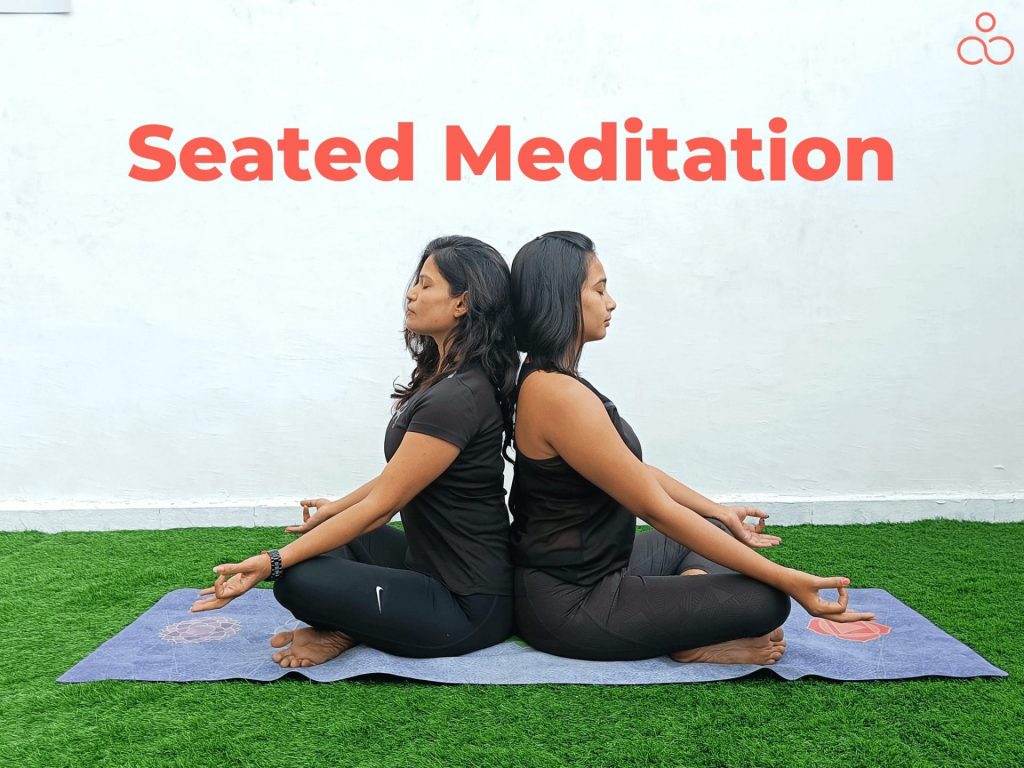
How to do?
Both the buddies would be performing the same series of steps to reach the pose but with their backs facing each other.
- Sit comfortably with your legs crossed and feet placed on above your knees.
- Lengthen the spine by pushing your hip bones towards the mat
- Relax your shoulders, belly, and face muscles.
- Extend your arms straight and position on the knees. Let your fingers loose, or you could even hold your desired mudra.
- Take deep breaths through your nose and feel the air reach till your belly. Exhale slowly and continue this process with your eyes closed.
- Feel the connection with your partner, as you continue to hold the pose together.
Benefits
- Opens the hips
- Aligns the spine
- Improves concentration
- Calms the mind
- Brings in body and mind stability
- Alleviates lower back pain
- Reduces stress
- Improves cardio-metabolic rate
- Promotes digestion
- Strengthens the pelvic and core muscles
- Corrects body posture
2. Double Twisted Chair Pose
Parivrtta Utkatasana, also called the Twisted Chair Pose, is a standing pose that goes deeper into your thoracic spine while holding your core intact in the chair pose. In this pose both Person A and Person B move parallelly into the same pose while standing with their backs facing each other.

How to Do?
- Start in the mountain pose
- Raise your arms above and extend them inline with your ears
- Shift the weight of your body on your heels and slowly bend forward to get into the chair pose
- Position your knees and ankles in line. Go lower and bring your hands to the prayer pose.
- Support the elbow on the opposite knee while you continue to hold the anjali mudra
- Hold your revolved chair pose for a few breaths.
Benefits!
- Improves body balance and stability
- Improves posture
- Opens Chest
- Strengthens the leg and back muscles
- Improves mobility and flexibility
3. Partner Half lord of the fishes Pose (Ardha Matsyendrasana)
Ardha Matsyendrasana better know also as the Half lord of the fishes Pose. Partner twist is known as a detox pose. It helps you to release toxins and clean out any bad food or drink you might have consumed the night before. This is just for information; no one’s judging.
This pose will leave you feeling rejuvenated and fresh. Focus on your breathing to reap all the benefits of this winner pose.
Make sure you begin with a straight back and are sitting comfortably against each other. Repeat on both sides a few times to activate the right muscles.
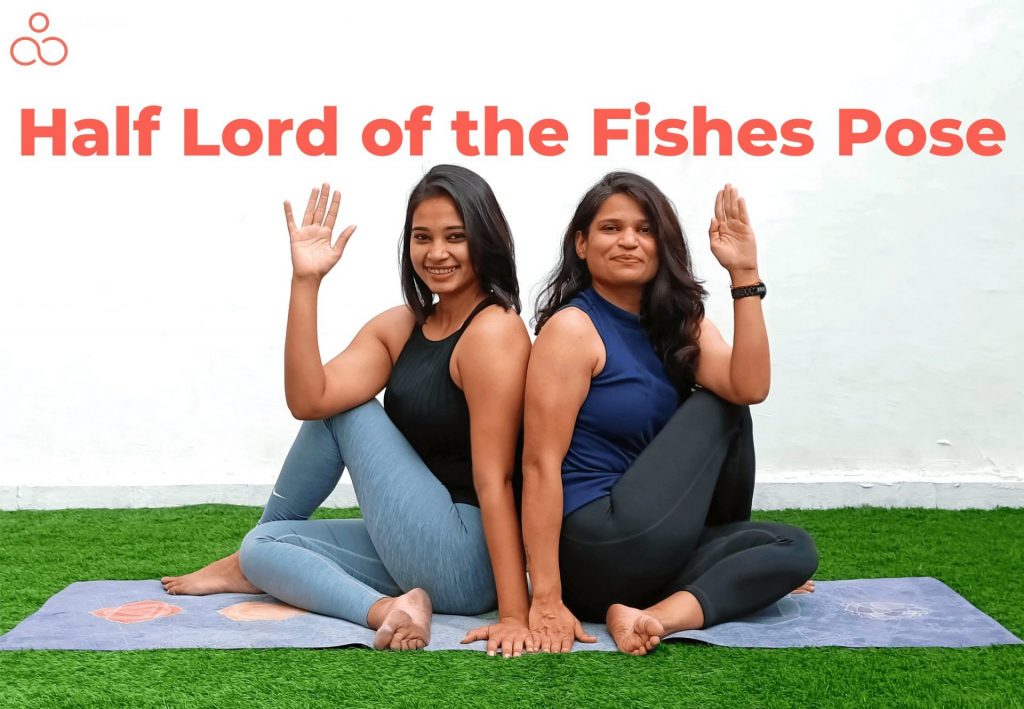
How to do?
Both the buddies will be sitting on the mat in opposite directions, with their backs facing each other.
- Sit with your legs stretched out and relax.
- Bend the right leg and position the right heel near the left hip
- Now, cross over the left leg across the right knee and balance the ankle against the right knee.
- Support your posture by placing the left palm straight on the ground and bend your right hand to give a slight push to your left knee with the elbow.
- Both the buttocks must remain in contact with the mat and the back must be straight.
- Hold the pose with your buddy and enjoy!
Benefits
- Restores the natural spine alignment
- Stimulates the liver, spleen, and pancreas
- Alleviates stress
- Rejuvenates the nervous system
- Improves lung functioning
- Promotes better sleep
- Stretches the thighs, abdomen, and buttocks
- Lowers constipation
4. Partner Seated Wide-Legged Forward Bend
Upavistha Konasana, also called the Seated Wide-Legged Forward Bend, is an excellent pose to work with your partner for all its calming effects.In this pose, both Person A and Person B will be sitting facing each other and legs stretched wide.
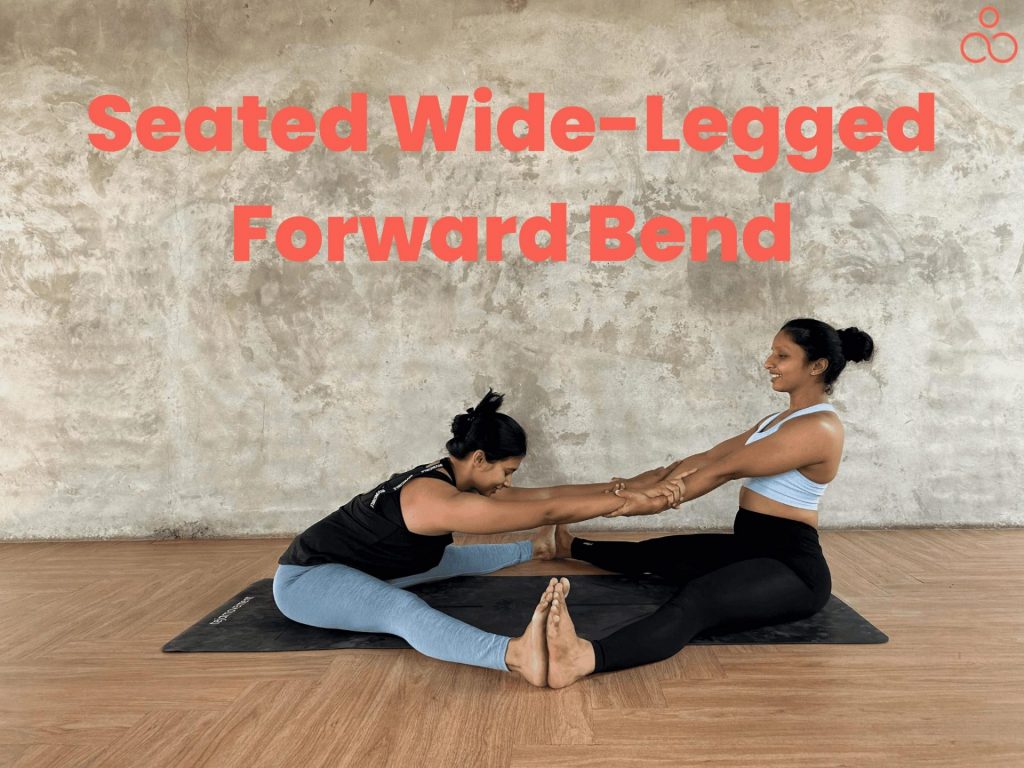
Surely you should let your BFF also pull you!
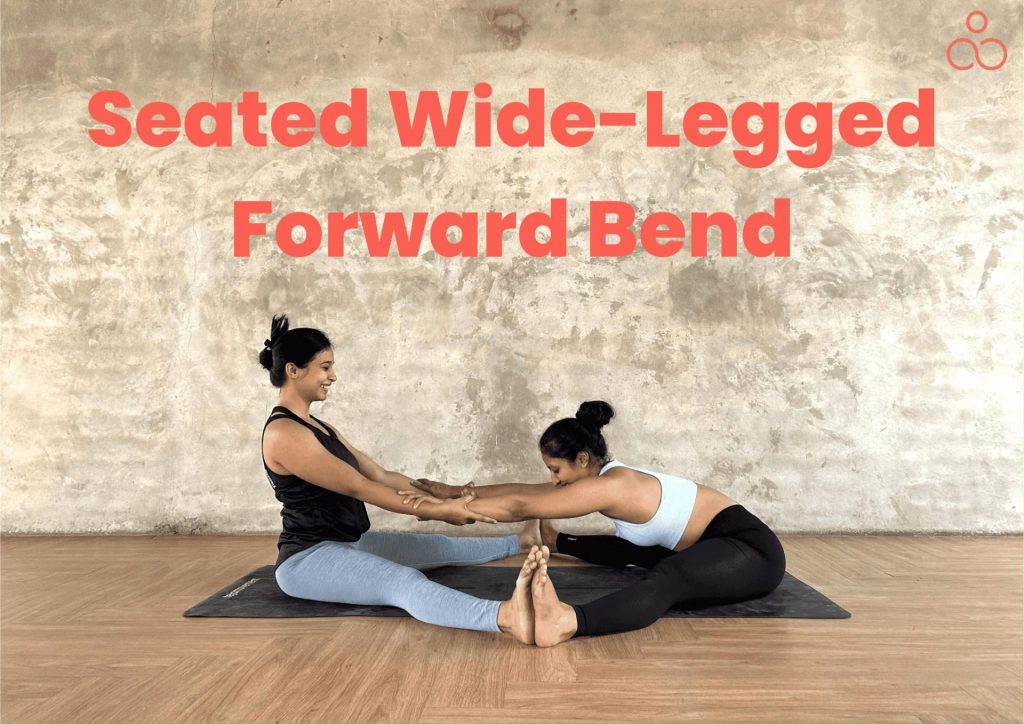
How to Do?
- Start by sitting in the staff pose
- Stretch open our legs wide and point your toes up.
- Lengthen the spine and slowly bend forward to position your upper body between your legs.
- Ensure your spine is straight.
- Engage with your partner by holding their hands and feeling the stretch while they slightly pull you forward.
- Remember the soles of your feet must be touching each other and your spines straight in their positions.
Benefits!
- Lengthens the hamstrings, calves, and glutes
- Stretches the spine and back muscles
- Alleviates stress and anxiety
- Opens the hips
- Calms the mind
5. Double Warrior III
Virabhadrasana III, also called the Warrior III pose, is a standing pose that promotes body balance. It is an intermediate level pose and helps to workout on all muscle groups in the body. In this pose, both Person A and Person B work on building into the same pose while standing facing each other.
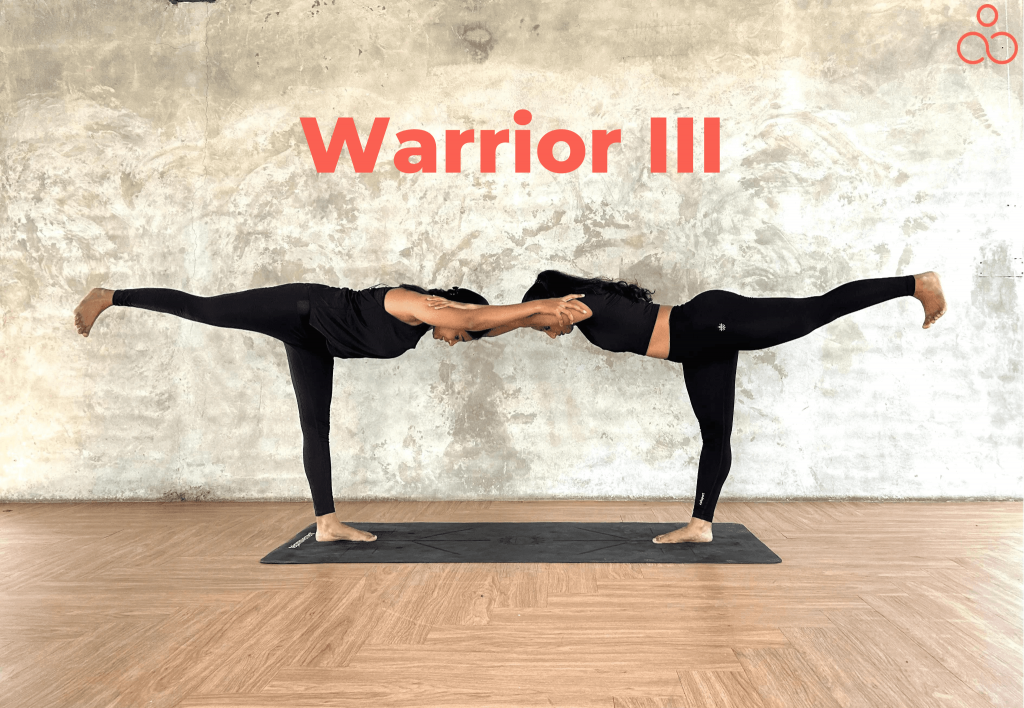
How to Do?
- Stand straight with your feet shoulder-width apart.
- Place your palms together near your chest with fingers spread wide.
- Slowly bend forward and raise one leg backward.
- Look down to the floor and extend the leg straight back to align it in line with the spine.
Benefits!
- Strengthens the leg and back muscles
- Improves the overall body balance
- Develops physical stability
- Stretches the back and leg muscles
- Builds Core strength
6. Double Cow Face Pose
Gomukhasana or as we called in the west “cow face pose.” This is a great pose for opening up your hips. Cow face pose requires you to sit on your hips and stretch your glutes. It also flexes your shoulders, muscles and outer legs. This particular pose can be challenging for people with stiff hips and shoulders. If you are breathing through this pose, it will allow your muscles to open up slowly.
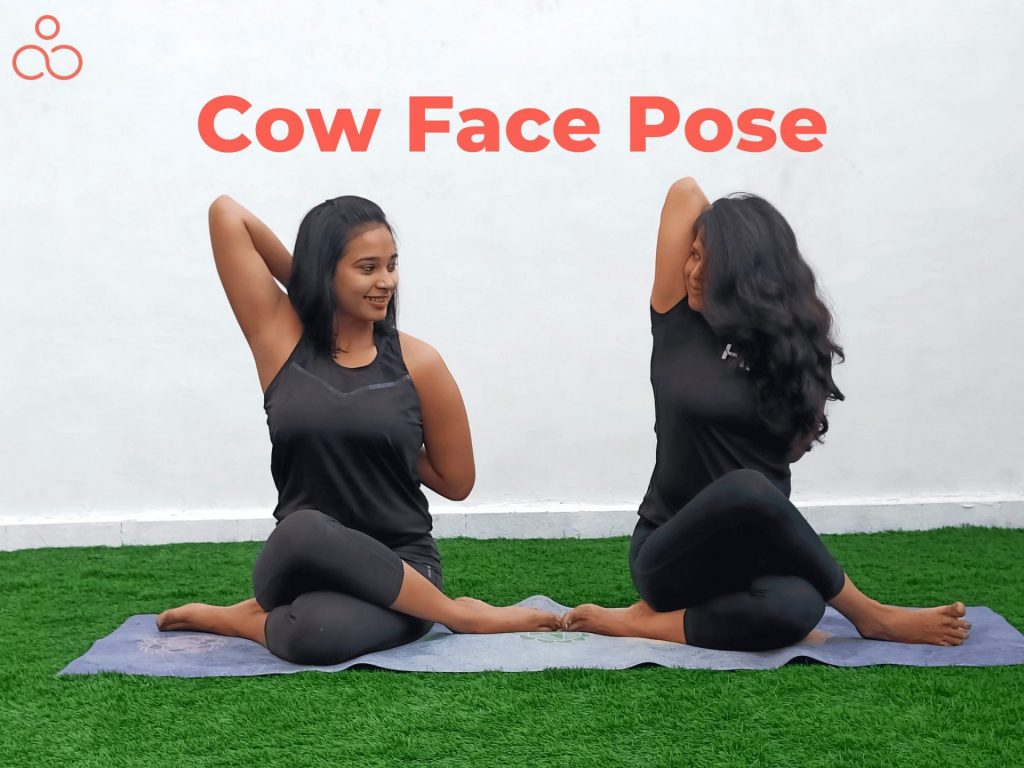
How to do?
Both the buddies must sit next to each other facing towards the same direction..
- Sit with your legs stretched out comfortably and loosen your body.
- Slowly, fold your legs and criss-cross them in a manner where both the knees are stacked one on top of the other.
- Keep your back straight.
- Fold your hands and extend them backwards as shown in the picture. Try to lock the fingers of your hands.
- Once the position is set, you can have eye contact with your partner and continue to smile and talk while you both reap the benefits of the pose!
Benefits
- Alleviates stress and anxiety
- Loosens the shoulders and removes tension
- Opens up the chest
- Stretches the inner thighs
- Flexes the back
- Improves sexual health
- Stimulates the kidneys
7. Double Tree Pose
Double Tree pose (in India better known as Vrksasana) can be the game-changer. With your partner’s support, you will find it’s really easy to balance
For all couples yoga poses, breathing through is important. Focus on self-awareness and being present. Take a moment to feel this state and be grateful for what your body is capable of. If you fall, just laugh.
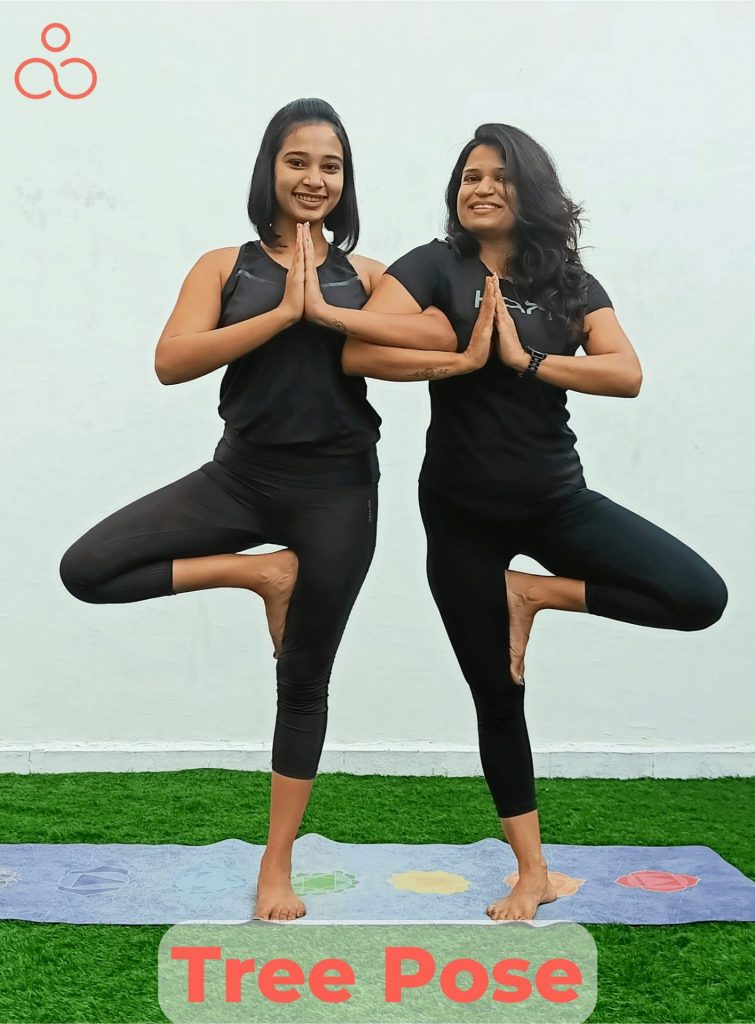
How to do?
Both the partners must stand next to each other, both facing the same direction.
- Stand with your legs at a shoulder distance positioned firmly on the mat.
- Keep your inner legs intact.
- Fold the outer leg and place the sole on the inner thigh of the inner leg.
- Lock your inner arm with your partner around the elbows.
- Both of you must individually get into the tree pose by now.
- Complete it with a namaskara and balance with the arm lock.
Benefits
- Strengthens the legs
- Improves body posture
- Enhances concentration
- Develops neuromuscular coordination
- Increases concentration and focus
- Improves body balance
- Strengthens the hips and pelvic muscles
8. Partner Standing Forward Bend
Urdhva Uttanasana, also called the Standing Forward Bend, works like a warm-up pose that helps prepare the body for many intense poses.In this combination pose, both Person A and Person B work to build up on the same pose while standing opposite to each other.
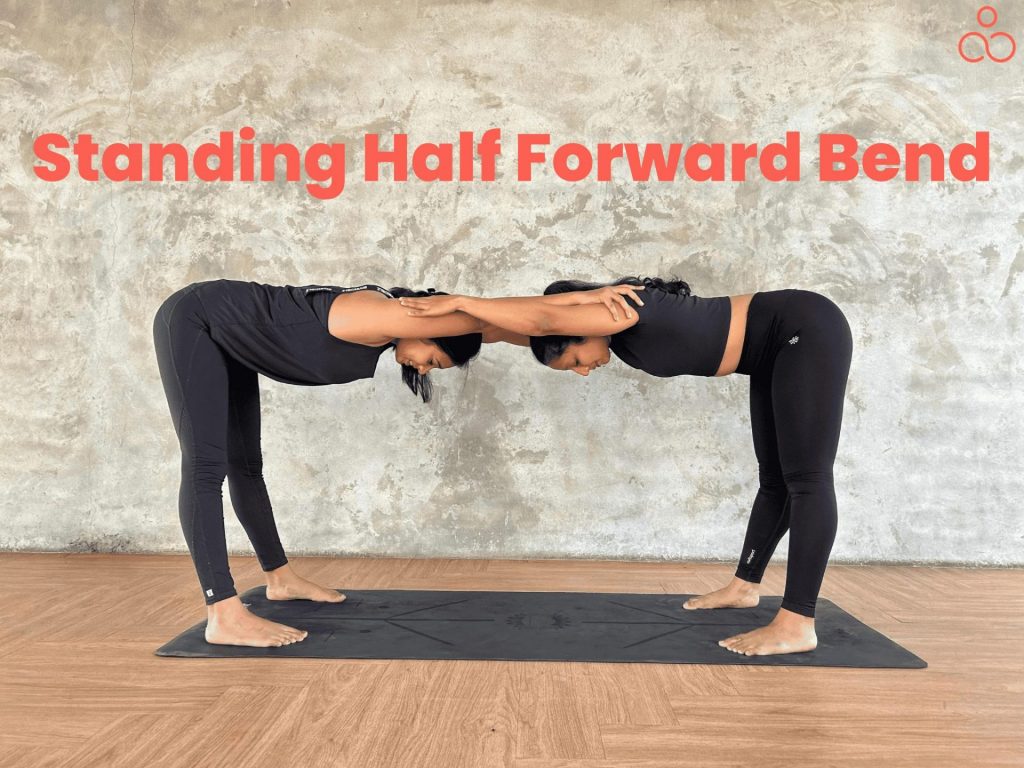
How to Do?
- Stand straight by keep your feet shoulder-width apart
- Bend forward from the hips, keep your chest open, and knees straight
- Keep your shoulders open and extend your arms to hold the palms of your partner (who is also in the same position)
- Hold for a few moments and release.
Benefits!
- Alleviates stress levels
- Strengthens Legs and spine
- Improves digestion
- Reduces fatigue
- Stimulates Kidneys and Liver
Let’s continue with the intermediate poses:
9. Partner Lord of the Dancer’s Pose + Revolved Triangle Pose
The Natarajasana, also called the Lord of the Dancer’s Pose, looks like you are in a ballet class. On the other hand, the Parivrtta Trikonasana, also called the Revolved Triangle Pose. This is a combination pose where Person A can do Natarajasana and Person B can get into the Parivrtta Trikonasana. You can reverse the roles and try the opposite poses in the next cycle!

How to Do?
Person A – Lord of the Dancer’s Pose
- Begin in Mountain Pose keeping in mind the appropriate alignment of your torso and pelvis.
- Draw one leg toward your chest and find a focal point in front of you to find the right balance.
- Slowly, grab your folded leg with your hand and pull it backwards.
- Continue to hold your balance on the standing leg.
- Bend forward as you pull your folded leg to the back, to create the right body balance.
- Extend your free arm outward trying to reach something.
Person B – Revolved Triangle Pose
- Stand straight with your feet spread wider than your shoulders.
- Slowly, shift the position and angle of your feet to one direction, say left here.
- Extend your arms outward.
- Try to touch the mat near your left foot with your right hand by bending forward.
- Extend your left arm above the head.
- Tilt your head to see the palm of your left hand. Hold your position like this for a few seconds.
Remember to bring the connection! Person A must hold the free hand of Person B.
Benefits!
Lord of the Dancer’s Pose
- Stretches the hamstrings, calves, and quadriceps.
- Strengthens the abdominal muscles
- Improves body flexibility
- Opens the chest and tones the muscles
- Stretches the lower back
Revolved Triangle Pose
- Strengthens and stretches the legs, hamstrings, spine, and hips
- Stimulates abdominal muscles and helps digestion.
- Lowers Stress
- Lengthens the spine
- Improves stability and balance
10. Partner Lord of the Dancer’s Pose
Lord of the Dancer’s Pose, also known as Natarajasana. This is recommended for the flexible ones. If you are comfortable stretching it out comfortably, give it a go. Provide support with your partner’s needs. They will need it more if they are new to this. Hold each other’s hands to provide reassurance.
These nice and easy BFF 2 person yoga poses will be completely based on the trust you both share, which can be beautiful, so don’t forget to Instagram it.
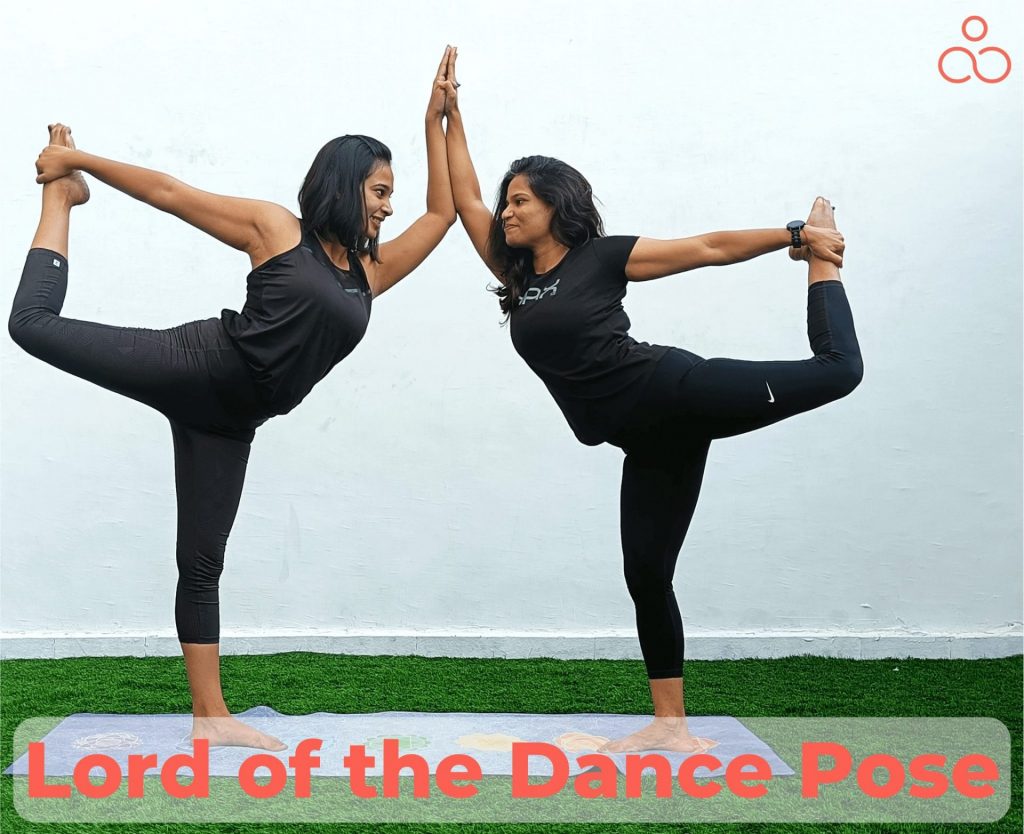
How to do?
Both the buddies must stand facing opposite to each other with a double arm gap between the two of you.
- Keep your inner leg straight and the foot positioned well on the mat.
- Extend your outer legs back and push them up in the air.
- Hold your extended leg at the foot with your outer hand. You might feel a good stretch in your body.
- Balance the pose by joining the inner hand with your partner’s inner hand and slightly extend them upward with a push to retain the pose.
- Keep your gaze straight and engage.
Benefits
- Improves balance and focus
- Opens chest and shoulders
- Tones the muscles
- Alleviates stress
- Increases body strength
- Enhances lung capacity
- Develops flexibility
11. Double Extended Side Angle Pose
Utthita Parsvakonasana, also called the Extended Side Angle Pose, is a standing pose that is commonly used in modern styles of yoga. This is a side stretch pose and both Person A and Person B build together by standing opposite to each other.
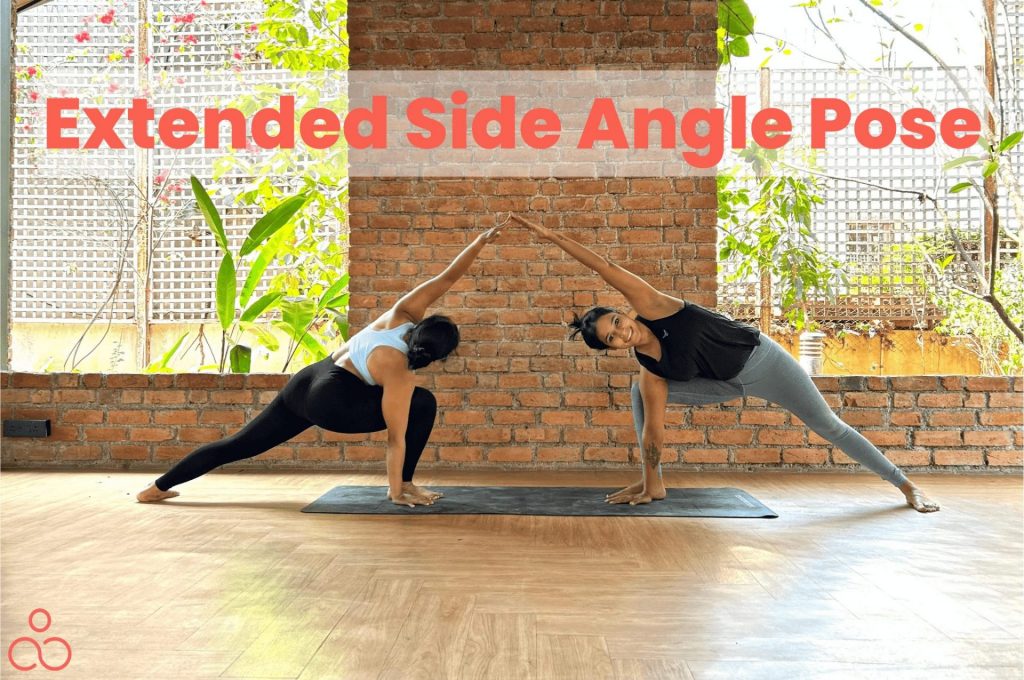
How to Do?
- Stand straight with your feet stretched wider than your shoulders.
- Turn the angle of your left foot and bend your left knee
- Extend your right leg back
- Stretch your body sideways with your right hand raised and extended above the head.
- Tilt your head and focus your gaze towards the right palm
Benefits!
- Stretches the legs, hamstrings, and hips
- Opens the chest and shoulders
- Strengthens the legs and core
- Used for therapeutic applications
12. Double Compass Pose
Surya Yantrasana, also called the Compass Pose, is a seated pose that twists enough to give a deep pull in your hips, shoulder, and hamstrings. In this combination pose, both Person A and Person B, move into the same seated compass pose while sitting with their backs facing each other.

How to Do?
- Sit comfortably on the mat with your legs folded.
- Extend your left knee up in front of you while keeping your spine intact.
- Pull your leg in an inverted ‘L’ shape. Hold the left heel with your right hand and the left calf with your left hand to give the right support to the leg.
- Slowly work your hands to create space and extend the left leg up over the head.
- Hold your left foot with your right arm that goes over your head. Position your head between the left inner thigh and the right inner arm.
- Gradually straighten your leg as much as you can while keeping the stretch in your left arm on the ground intact.
Benefits!
- Improves your posture
- Strengthens the core
- Develops spinal flexibility
- Stretches the shoulders and hips
- Opens the chest
- Improve balance and coordination
- Tones the muscles throughout the body
13. Double Buddy Boat Pose
The orginal sanskrit name for this pose Paripurna Navasana, or simply boat pose. This is the best pose if you love to stretch your hamstrings. It goes all the way out with the added support and strength from your partner. Don’t worry if you are not able to straighten your legs fully. Take it slow and focus on your breathing; you will get there one day.
Balancing can be a challenge in this pose. But be sure to have a lot of fun with this one. If you fail at first, try again until you reach that balance. Use each other’s body weight to tune into it comfortably.

How to do?
Both the buddies must sit facing opposite to each other. Ensure to maintain enough gap to get into the pose.
- Extend your leg and join your sole of the feet with that of your partner’s.
- Lift the legs upward while keeping the hold intact together.
- Now, extend your arms forward and lock your fingers with your partner.
- Keep your spine straight and gaze forward.
- Enjoy holding this pose.
Benefits
- Strengthens the core and quads.
- Stimulates kidneys, thyroid gland, and intestines.
- Alleviates stress
- Enhances digestion
- Strengthens spine and hip flexors
- Improves blood circulation
- Lowers belly fat
14. Double Side Plank Leg Raises
Vasisthasana, also called the Side Plank Leg Raises, are a great workout for strengthening the abs and glutes. In this combination pose. Both Person A and Person B perform the same Side Plank Leg Raises but on opposite sides.
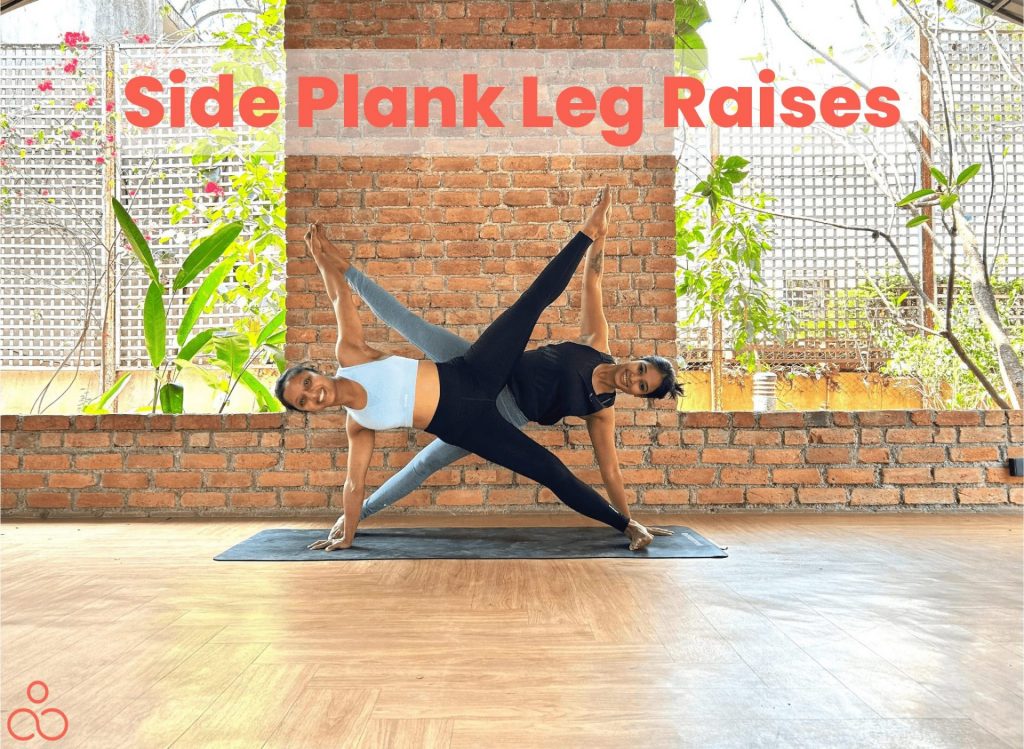
How to Do?
- Start in your regular plank pose with your arms lined under your shoulders and your feet positioned hip-width apart.
- Slowly turn your body to your left, balance your weight on your left upper arm and the left foot while still aligning your body in a line.
- Lift your right hand and leg up above your head and hip, respectively.
- Hold this pose for a few seconds before swapping the positions and attempting the same on the other side.
Benefits!
- Strengthens the spine
- Develops balance, stability, and coordination
- Tones the legs, glutes, and shoulders
Let’s finish with the advanced poses:
15. Double Partner Downward Dog
Adho Mukha Svanasana or downward dog is probably one of the most famous Asana. This pose will hit you in way too many places, but the right ones. If you are new to this, you may not know, but the downward dog pose activates your back, neck, shoulder, legs, and everything else. Having a partner to do this pose with can open up your spine a little extra.
You are allowed to have a little fun as well. Talk to each other about your pressure points and how you are feeling. If something feels off, please remember to communicate. Communication is key in this fun and friendly pose, so make sure you’re being verbal with your partner about what feels comfortable and what doesn’t. Plus, always remember to signal when you’re ready to come down from the pose.
When you want to come back down into your standing pose, make sure to give each other a heads up.
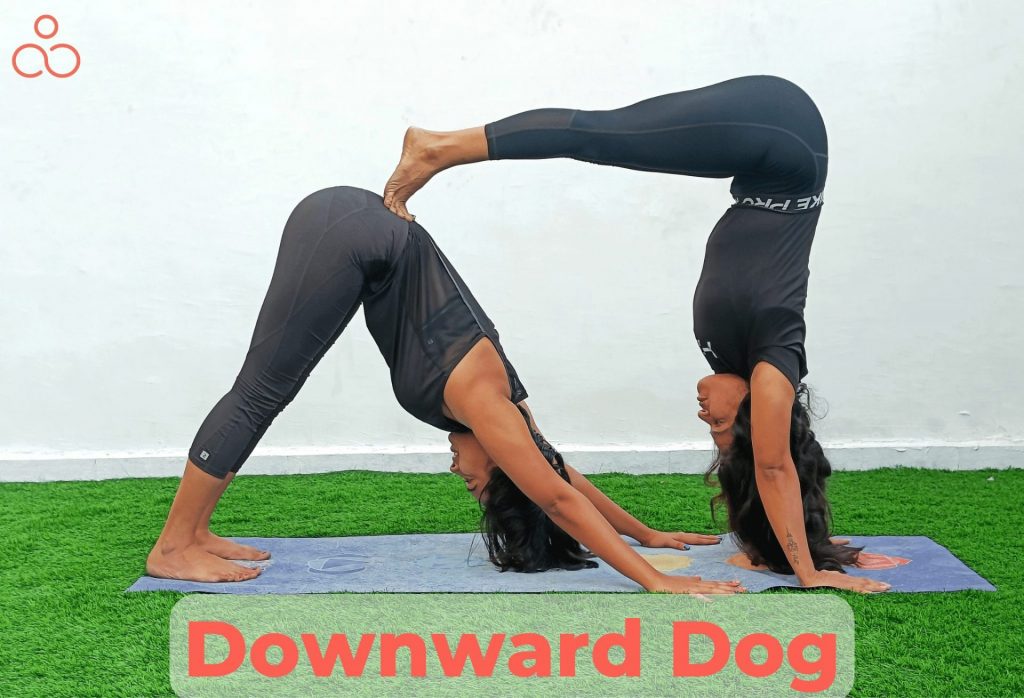
How to do?
Both the buddies must be standing on the mat one behind the other. This is an advanced pose, so try this only if both of you are comfortable enough to handle the combination.
- Person A must get down on all fours with an appropriate alignment.
- Palms and feet at shoulder-width apart and must be positioned well on the mat or ground.
- Person B must now bend forward and position their palms strongly grounded into the mat or ground.
- Now, they must list their legs off the ground, one at a time and place them on the sacrum of Partner A.
- Partner B would be forming like an inverted ‘L’ and hold balance on Partner A.
- Hold the pose and release in reverse order.
Benefits
- Improves digestion
- Alleviates stress, anxiety, and depression
- Strengthens the upper body
- Enhances blood circulation
- Stretches and mobilizes the spine
16. Double Tripod Headstand
Mukta Hastha Sirsasana, also called the Tripod Headstand, is an inversion pose where your heart is higher than your head and the entire body weight is balanced on your arms.It is a great pose to practice with your BFF, as you can benefit from the slight support that you get from each other. In this pose both of you attain the same posture – The Tripod Headstand.

How to Do?
- Begin on all fours and position your head on the ground.
- Position your palms a couple of inches in front of your face with fingers facing towards you.
- Walk your feet slowly towards your torso and then fold them to create a balance like a step before the actual ascent.
- Lift your body up in the air while balancing your entire weight on the head and your hands creating the shape of a tripod.
- Once both of you attain the final position, you can support each other by balancing with your feet touching at the back.
Benefits!
- Strengthens the spine, neck, shoulders, and arms
- Rejuvenates the mind
- Improves blood circulation
- Eases back pain
- Lengthens the spine
17. Partner Child’s Pose + Crow Pose
This is a combination pose where Person A and Person B build into two different poses Balsana (Child’s Pose) and Bakasana (Crow Pose). Depending on the levels of expertise, strength, and stamina, you can decide on who should pick which pose. If both of you are comfortable you can try both the options in alternative cycles.

How to Do?
Person A – Child’s Pose
- Sit on your heels and position your knees at a width that is equivalent to your hip.
- Bend forward and position your thighs in between your thighs
- Feel the stretch along your spine while you place your head down and extend your tail bone outward.
- Extend your arms outward with your palms down.
- As you get in the pose you will experience a pull in the shoulder blades and a stretch through your back.
Person B – Crow Pose
- Start in the Mountain pose.
- Bend forward and place your palms firmly on the ground at shoulder width.
- Slowly bend your elbows and position your knees on the upper arms
- Build your weight steadily on your hands and lighten up your body to take ascent like a bird
- With the support of our arms on your thighs, lift off one leg at a time.
- Keep your feet tucked closer to your hip bone and focus on the alignment to avoid sinking or collapsing.
In this combination, the Crow Pose is built or stacked on top of the person doing the Child’s Pose.
Benefits!
Child’s Pose
- Strengthens the abdominal organs and improves digestion
- Calms the mind
- Energizes and rejuvenates the body and mind
- Tones the hip muscles
- Improves mobility
- Strengthens the ligaments and tendons
- Improves blood circulation
- Enhances flexibility
- Promotes sleep
Crow Pose
- Strengthens the arms and wrists
- Builds Core strength
- Stretches the upper back
- Develops balance and stability
- Increases Coordination
18. Partner Lord of the dancer pose II + Headstand
In this combination pose, Person A and Person B, work on two different poses Natarajasana II and Sirsasana, respectively. Natarajasana II, is similar to the regular Lord of dancer pose with a variation in the position of the hands. Sirsasana, also called the headstand, is an inversion pose where your head goes below the position of your heart.
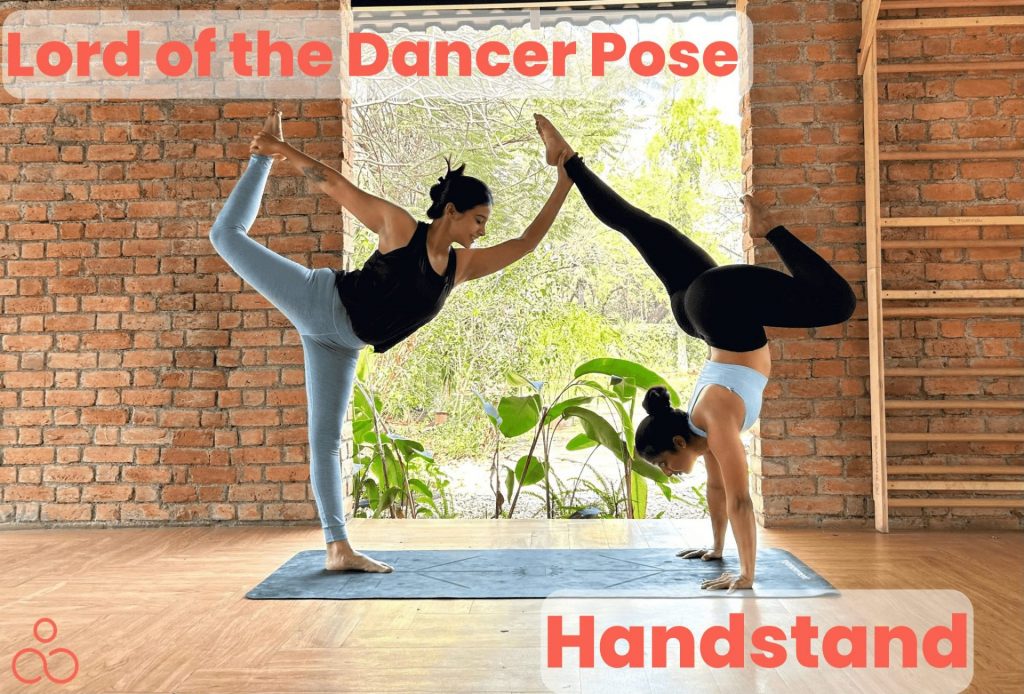
How to Do?
Person A – Lord of the dancer pose II
- Begin in Mountain Pose keeping in mind the appropriate alignment of your torso and pelvis.
- Draw one leg toward your chest and find a focal point in front of you to find the right balance.
- Slowly, grab your folded leg with your hand and pull it backwards.
- Continue to hold your balance on the standing leg.
- Bend forward as you pull your folded leg to the back, to create the right body balance.
- Extend your free arm outward trying to reach something. Here, in this pose, hold the extended leg of Person B, in Sirsasana.
Person B – Headstand
- Start on your fours, with your wrists and knees positioned in line with your knees and hips.
- Interlace your fingers and get a firm grip on the ground with your elbows shoulder-width apart.
- Position the crown of your head on the ground, somewhere close to the thumbs.
- Walk your steps as in a downward dog pose and move them closer to the chest and prepare to slowly lift off the ground.
- Now, lift your hips and legs up above and straighten them outward.
- Once you find the balance, try to do the combination pose by folding one leg and extending the other leg slightly backward towards your partner.
Benefits!
Lord of dancer pose //
- Stretches the hamstrings, calves, and quadriceps.
- Strengthens the abdominal muscles
- Improves body flexibility
- Opens the chest and tones the muscles
- Stretches the lower back
Headstand
- Improves blood circulation
- Enhances lung capacity
- Lowers stress and depression
- Stimulates abdominal organs
- Strengthens the core and spine
- Stimulates the abdominal organs
19. Partner Wheel Pose
Urdhva Dhanurasana, also called the Wheel Pose, is a backbend pose that requires a strong flexibility. In this combination pose, both Person A and Person B move into the same Wheel pose. However, Person A layers the leg balance on Person B, bringing in a connection.
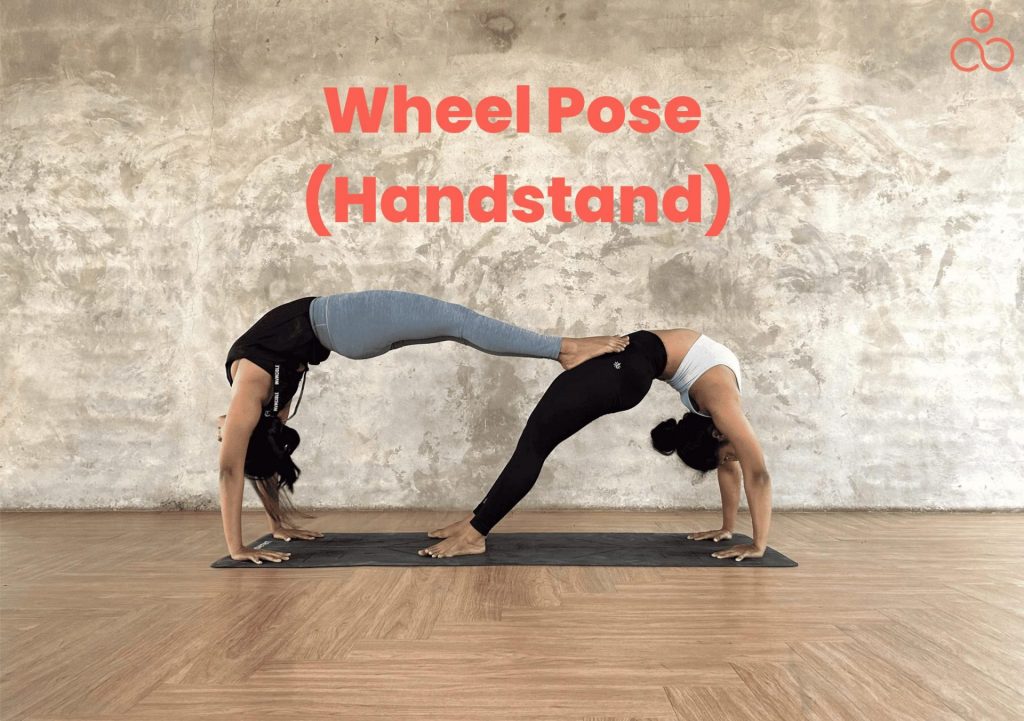
If you are looking for a deeper stretch and a more challenging pose, try it this way!

How to Do?
- Start by lying on your back.
- Bend your knees, position them hip-width apart, and close to your buttocks.
- Bend your elbows, position your palms firmly on the ground, underneath your shoulders with the fingers pointing towards the feet.
- Slowly, lift your torso off the ground while bringing your head closer to the ground.
- Once you stabilize your weight, bring in the perfect arch by straightening your arms and lifting the head slightly off the mat. For a more challenging version try balancing on your elbows, trust us it is much harder.
Benefits!
- Opens the chest
- Improves lung capacity
- Lengthens the spine
- Stretches the core, hip flexors, and shoulders
- Strengthens the core, arms, and legs
Conclusion
Performing couples yoga can be adventurous and challenging. There are no rules about how many times a week you should be attending a couples yoga class, so you are free to do it on weekends as a fun activity. You can even go yoga shopping, buy the right outfits and get matching mats, etc.
Just a small reminder for you to warm up before jumping into a couple yoga poses. Remember to communicate with each other. You may be feeling a certain way mentally, or even physically that your partner is unaware of. We advise you to speak up before they pull your arms and legs.
Pairing your fitness journey with pleasure will be the best decision you’ve ever made, and we promise you will have a fabulous yoga session (remember, two’s a party). So enjoy being the student and teacher for your yoga partner.

